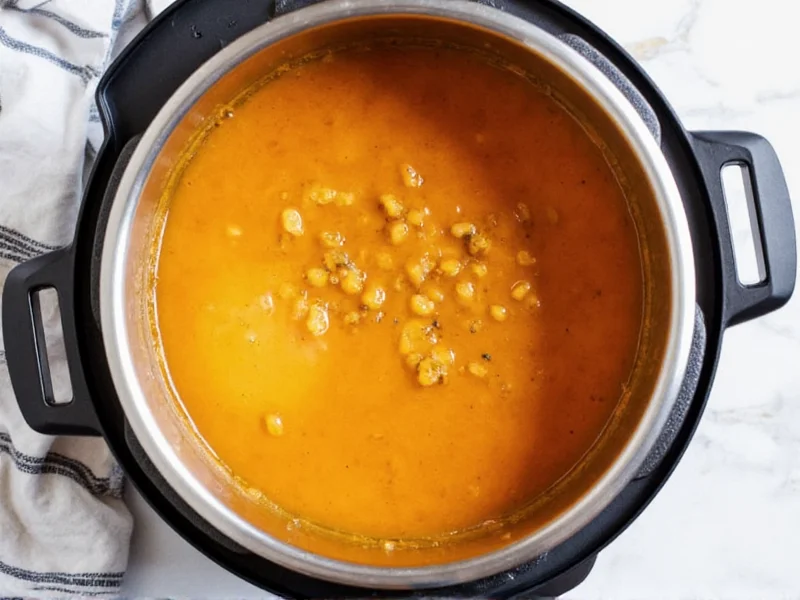Creating delicious soup with an Instant Pot transforms a traditionally time-consuming process into a quick weeknight solution. The sealed high-pressure environment forces liquid into ingredients faster than conventional methods, extracting flavors while preserving nutrients. Unlike slow cookers that take 6-8 hours, an Instant Pot delivers restaurant-quality soup in under 30 minutes from start to finish.
Why Instant Pot Excels for Soup Making
The science behind pressure cooking explains its superiority for soup preparation. When sealed, the Instant Pot creates 12-15 psi of pressure, raising the boiling point of water from 212°F to approximately 250°F. This higher temperature accelerates the breakdown of connective tissues in meats and fibers in vegetables, creating rich broths without lengthy simmering.
Key advantages over traditional methods include:
- Time efficiency - Complete soups in 20-30 minutes versus 2+ hours
- Flavor concentration - Minimal evaporation preserves volatile flavor compounds
- Energy savings - Uses 70% less energy than stovetop simmering
- Safety features - Automatic pressure release and lid locking prevent accidents
| Soup Type | Traditional Time | Instant Pot Time | Time Saved |
|---|---|---|---|
| Chicken Noodle | 90-120 minutes | 20 minutes | 83% |
| Beef Stew | 3-4 hours | 35 minutes | 88% |
| Lentil Soup | 60 minutes | 15 minutes | 75% |
| Tomato Basil | 45 minutes | 10 minutes | 78% |
Essential Instant Pot Soup Techniques
Master these fundamental methods to avoid common pitfalls when making soup with instant pot:
Searing Before Pressure Cooking
Always use the sauté function to brown meats and soften aromatics before pressure cooking. This Maillard reaction creates complex flavor compounds that simmering alone cannot achieve. For vegetarian soups, sautéing onions, garlic, and spices in oil for 3-5 minutes develops a flavor foundation that permeates the entire dish.
Liquid Requirements
Instant Pots require minimum liquid levels to create proper pressure. For 6-quart models, use at least 1 cup of liquid; for 8-quart models, use 1.5 cups. When making broth-heavy soups, maintain a 2:1 ratio of liquid to solid ingredients. Too little liquid causes burn errors, while excessive liquid dilutes flavors.
Pressure Release Methods
Choose the appropriate release method based on soup ingredients:
- Natural release (10-20 minutes) - Essential for creamy soups, bean soups, and dishes with starches to prevent foaming and spitting
- Quick release - Ideal for vegetable-based soups to maintain texture and color
Top 3 Foolproof Instant Pot Soup Recipes
Classic Chicken Noodle Soup
This how to make soup with instant pot favorite delivers comforting flavor in record time. The pressure cooking process extracts maximum flavor from bones while keeping vegetables perfectly textured.
Ingredients:
- 1 tbsp olive oil
- 1 onion, diced
- 3 carrots, sliced
- 3 celery stalks, sliced
- 4 cups chicken broth
- 2 cups water
- 1 lb chicken breasts
- 2 tsp salt
- 1 tsp pepper
- 2 cups egg noodles
- 2 tbsp fresh parsley
Instructions:
- Use sauté function to cook onion, carrots, and celery for 5 minutes
- Add broth, water, chicken, salt, and pepper
- Seal lid, set to manual high pressure for 12 minutes
- Allow 10-minute natural release, then quick release remaining pressure
- Remove chicken, shred, and return to pot
- Add noodles, seal lid, and cook on sauté for 5 minutes until tender
Hearty Beef Stew
This instant pot soup recipe for beginners transforms tough cuts into fork-tender morsels through precise pressure control. The high temperature breaks down collagen into gelatin, creating a naturally thickened broth.
Key technique: Cut beef into uniform 1.5-inch cubes to ensure even cooking. Smaller pieces overcook while larger ones remain tough.
Troubleshooting Common Instant Pot Soup Issues
Burn Error Prevention
Burn messages occur when food sticks to the bottom. Prevent this by:
- Always deglaze after sautéing (scrape bottom with broth or water)
- Maintaining proper liquid-to-solid ratios
- Avoiding thick sauces or purees in initial cooking
- Layering starchy ingredients above liquids
Texture Management
For best results with instant pot soup cooking time considerations:
- Add delicate vegetables (zucchini, spinach) after pressure cooking
- Cook pasta and grains separately to prevent mushiness
- Use natural release for soups containing beans or lentils
- Blend only after complete pressure release to avoid splattering
Storage and Reheating Guidelines
Proper handling maintains soup quality for future meals:
- Cool soup within 2 hours of cooking
- Store in airtight containers for up to 4 days refrigerated
- Freeze in portion-sized containers for up to 3 months
- Reheat on sauté function at medium temperature, stirring occasionally
When reheating frozen soup, add 1-2 tablespoons of liquid as freezer burn can cause slight drying. Never reheat soup using pressure cooking function as this overcooks ingredients.
Frequently Asked Questions
Can I make cream-based soups in an Instant Pot?
Yes, but add dairy after pressure cooking. Cooking cream or milk under pressure causes separation. For best results, use the sauté function after pressure cooking to gently heat dairy ingredients while stirring constantly.
How much less liquid do I need for Instant Pot soup versus stovetop?
Reduce liquid by 20-30% compared to traditional recipes. The sealed environment prevents evaporation, so soups won't reduce in volume during cooking. Start with less liquid and add more after cooking if needed.
Why does my Instant Pot soup taste different than stovetop versions?
The higher cooking temperature creates different flavor compounds. To mimic slow-cooked flavor, include umami-rich ingredients like tomato paste, soy sauce, or dried mushrooms. The pressure cooking process also extracts more flavor from bones and vegetables, creating a more concentrated broth.
Can I double an Instant Pot soup recipe?
Only if the recipe specifically indicates it's tested for doubling. Doubling ingredients without adjusting liquid ratios or cooking times often causes burn errors. For larger batches, cook in separate batches rather than overfilling the pot beyond the 2/3 fill line.











 浙公网安备
33010002000092号
浙公网安备
33010002000092号 浙B2-20120091-4
浙B2-20120091-4